Identify the Impacts of the Grand Ethiopian Renaissance Dam on Watershed Sediment and Water Yields Dynamics
Abstract
:1. Introduction
2. Materials and Methods
2.1. Study Site Description
2.2. Description of the Models
2.2.1. Annual Water Yield (AWY) Model
2.2.2. Sediment Delivery Ratio (SDR) Model
2.3. Data Sources
2.3.1. AWY Model Input Parameters
2.3.2. SDR Model Input Parameters
2.4. Calibration and Validation
3. Results
3.1. Spatio-Temporal Dynamics of Water Yields
3.2. Spatio-Temporal Dynamics of Soil Loss and Sediment Yields
3.2.1. Dynamics of Soil Loss
3.2.2. Sediment Yield Dynamics
3.3. Contributions of Land-Use Type for Water and Sediment Yields
4. Discussion
5. Conclusions
Supplementary Materials
Author Contributions
Funding
Institutional Review Board Statement
Informed Consent Statement
Data Availability Statement
Conflicts of Interest
References
- Fearnside, P.M. Environmental and Social Impacts of Hydroelectric Dams in Brazilian Amazonia: Implications for the Aluminum Industry. World Dev. 2016, 77, 48–65. [Google Scholar] [CrossRef]
- Velastegui-Montoya, A.; de Lima, A.; Herrera-Matamoros, V. What Is the Socioeconomic Impact of the Tucuruí Dam on Its Surrounding Municipalities? Sustainability 2022, 14, 1630. [Google Scholar] [CrossRef]
- UNDPC. Report on the Sustainable Development of Chinese Enterprises Overseas; United Nations Development Programme: Beijing, China, 2017. [Google Scholar]
- Scown, M.W. The Sustainable Development Goals Need Geoscience. Nat. Geosci. 2020, 13, 714–715. [Google Scholar] [CrossRef]
- Brundtland, G.H. Report of the World Commission on Environment and Development: Our Common Future; United Nations: Oslo, Norway, 1987. [Google Scholar]
- Zeng, Y.; Maxwell, S.; Runting, R.K.; Venter, O.; Watson, J.E.M.; Carrasco, L.R. Environmental Destruction Not Avoided with the Sustainable Development Goals. Nat. Sustain. 2020, 3, 795–798. [Google Scholar] [CrossRef]
- Elder, M.; Olsen, S.H. The Design of Environmental Priorities in the SDGs. Glob. Policy 2019, 10, 70–82. [Google Scholar] [CrossRef] [Green Version]
- Griggs, D. Sustainable Developmnet Goals for People and Planet. Nature 2013, 495, 305–307. [Google Scholar] [CrossRef]
- Johnston, R.; Smakhtin, V. Hydrological Modeling of Large River Basins: How Much Is Enough? Water Resour. Manag. 2014, 28, 2695–2730. [Google Scholar] [CrossRef] [Green Version]
- Awulachew, S.B.; McCartney, M.; Steenhuis, T.S.; Ahmed, A.A. A Review of Hydrology, Sediment and Water Resource Use in the Blue Nile Basin; International Water Management Institute: Colombo, Sri Lanka, 2008; Volume 131, ISBN 978-92-9090-699-5. [Google Scholar]
- Negm, M.; Abdel-Fattah, S. Grand Ethiopian Renaissance Dam Versus Aswan High Dam: A View from Egypt; Hutzinger, O., Dami a Barcelo, A.G.K., Eds.; Springer: Berlin/Heidelberg, Germany, 2019; Volume 79, ISBN 9783319955995. [Google Scholar]
- Verhoeven, H. Black Gold for Blue Gold? Sudan’s Oil, Ethiopia’s Water and Regional Integration; Chatham House: London, UK, 2011. [Google Scholar]
- Ahmed, A.T.; Helmy Elsanabary, M. Hydrological and Environmental Impacts of Grand Ethiopian Renaissance Dam on the Nile River. In Proceedings of the Eighteenth International Water Technology Journal, IWTJ18, Sharm El Sheikh, Egypt, 12–14 March 2015; Volume 5, pp. 336–347. [Google Scholar]
- Negm, A.; Elsahabi, M.; Abdel-Nasser, M.; Mahmoud, K.; Ali, K. Impacts of GERD on the Accumulated Sediment in Lake Nubia Using Machine Learning and GIS Techniques. In Handbook of Environmental Chemistry; Damià Barceló, A.G.K., Ed.; Springer: Berlin/Heidelberg, Germany, 2019; Volume 79, pp. 271–327. [Google Scholar]
- Dandrawy, M.E.; Omran, E.-S.E. Integrated Watershed Management of Grand Ethiopian Renaissance Dam via Watershed Modeling System and Remote Sensing; Springer: Berlin/Heidelberg, Germany, 2020; pp. 533–574. ISBN 9783030395933. [Google Scholar]
- Abera, W.; Haregeweyn, N.; Dile, Y.; Fenta, A.A.; Berihun, M.L.; Demissie, B.; Mulatu, C.A.; Nigussie, T.A.; Billi, P.; Meaza, H.; et al. Scientific Misconduct and Partisan Research on the Stability of the Grand Ethiopian Renaissance Dam: A Critical Review of a Contribution to Environmental Remote Sensing in Egypt (Springer, 2020). In Nile and Grand Ethiopian Renaissance Dam; Springer: Cham, Switzerland, 2021; pp. 273–293. [Google Scholar] [CrossRef]
- Heubl, B. Why Ethiopia and Egypt Can’t Agree over Hydro Dam|E&T Magazine. Available online: https://eandt.theiet.org/content/articles/2020/08/why-ethiopia-and-egypt-can-t-agree-over-the-grand-ethiopian-renaissance-dam-gerd-africa-s-largest-hydroelectric-power-project/ (accessed on 17 November 2020).
- Batisha, A.F. Sustainability Assessment in Transboundary Context: Grand Ethiopian Renaissance Dam. Model. Earth Syst. Environ. 2015, 1, 36. [Google Scholar] [CrossRef] [Green Version]
- Soliman, G.; Soussa, H.; El-Sayed, S. Assessment of Grand Ethiopian Renaissance Dam Impacts Using Decision Support System. IOSR J. Comput. Eng. 2015, 18, 2278–2661. [Google Scholar] [CrossRef]
- Zhang, Y.; Block, P.; Hammond, M.; King, A. Ethiopia’s Grand Renaissance Dam: Implications for Downstream Riparian Countries. J. Water Resour. Plan. Manag. 2015, 141, 05015002. [Google Scholar] [CrossRef]
- Aziz, S.A.; Zelenáková, M.; Mésároš, P.; Purcz, P.; Abd-Elhamid, H. Assessing the Potential Impacts of the Grand Ethiopian Renaissance Dam on Water Resources and Soil Salinity in the Nile Delta, Egypt. Sustainability 2019, 11, 7050. [Google Scholar] [CrossRef] [Green Version]
- Reyers, B.; Stafford-Smith, M.; Erb, K.H.; Scholes, R.J.; Selomane, O. Essential Variables Help to Focus Sustainable Development Goals Monitoring. Curr. Opin. Environ. Sustain. 2017, 26–27, 97–105. [Google Scholar] [CrossRef]
- Haregeweyn, N.; Tsunekawa, A.; Poesen, J.; Tsubo, M.; Meshesha, D.T.; Fenta, A.A.; Nyssen, J.; Adgo, E. Comprehensive Assessment of Soil Erosion Risk for Better Land Use Planning in River Basins: Case Study of the Upper Blue Nile River. Sci. Total Environ. 2017, 574, 95–108. [Google Scholar] [CrossRef] [PubMed] [Green Version]
- NBI Nile Basin Water Resources Atlas: Hydrology of the Nile; Chapter 6. Available online: https://nilebasin.org/index.php/information-hub/technical-documents/44-nile-basin-water-resources-atlas (accessed on 28 December 2020).
- Swain, A. Ethiopia, the Sudan, and Egypt: The Nile River Dispute. J. Mod. Afr. Stud. 1997, 35, 675–694. [Google Scholar] [CrossRef]
- Belete, M.; Deng, J.; Abubakar, G.A.; Teshome, M.; Wang, K.; Woldetsadik, M.; Zhu, E.; Comber, A.; Gudo, A. Partitioning the Impacts of Land Use/Land Cover Change and Climate Variability on Water Supply over the Source Region of the Blue Nile Basin. Land Degrad. Dev. 2020, 31, 2168–2184. [Google Scholar] [CrossRef]
- Aneseyee, A.B.; Elias, E.; Soromessa, T.; Feyisa, G.L. Land Use/Land Cover Change Effect on Soil Erosion and Sediment Delivery in the Winike Watershed, Omo Gibe Basin, Ethiopia. Sci. Total Environ. 2020, 728, 138776. [Google Scholar] [CrossRef]
- Zhou, M.; Deng, J.; Lin, Y.; Belete, M.; Wang, K.; Comber, A.; Huang, L.; Gan, M. Identifying the Effects of Land Use Change on Sediment Export: Integrating Sediment Source and Sediment Delivery in the Qiantang River Basin, China. Sci. Total Environ. 2019, 686, 38–49. [Google Scholar] [CrossRef]
- Sharp, R.; Nelson, E.; Ennaanay, D.; Wolny, S.; Olwero, N.; Vigerstol, K.; Pennington, D.; Mendoza, G.; Aukema, J.; Foster, J.; et al. InVEST User Guide; The Natural Capital Project: Stanford, CA, USA, 2014. [Google Scholar]
- Hamel, P.; Guswa, A.J. Uncertainty Analysis of a Spatially Explicit Annual Water-Balance Model: Case Study of the Cape Fear Basin, North Carolina. Hydrol. Earth Syst. Sci. 2015, 19, 839–853. [Google Scholar] [CrossRef] [Green Version]
- Belete, M.; Deng, J.; Zhou, M.; Wang, K.; You, S.; Hong, Y.; Weston, M. A New Approach to Modelingwater Balance in Nile River Basin, Africa. Sustainability 2018, 10, 810. [Google Scholar] [CrossRef] [Green Version]
- Zhang, L.; Hickel, K.; Dawes, W.R.; Chiew, F.H.S.; Western, A.W.; Briggs, P.R. A Rational Function Approach for Estimating Mean Annual Evapotranspiration. Water Resour. Res. 2004, 40, W02502. [Google Scholar] [CrossRef]
- Fu, B.P. On the Calculation of the Evaporation from Land Surface. Chin. J. Atmos. Sci. 1981, 5, 23–31. [Google Scholar]
- Donohue, R.J.; Roderick, M.L.; McVicar, T.R. Roots, Storms and Soil Pores: Incorporating Key Ecohydrological Processes into Budyko’s Hydrological Model. J. Hydrol. 2012, 436–437, 35–50. [Google Scholar] [CrossRef]
- Hamel, P.; Chaplin-Kramer, R.; Sim, S.; Mueller, C. A New Approach to Modeling the Sediment Retention Service (InVEST 3.0): Case Study of the Cape Fear Catchment, North Carolina, USA. Sci. Total Environ. 2015, 524–525, 166–177. [Google Scholar] [CrossRef] [PubMed]
- Borselli, L.; Cassi, P.; Torri, D. Prolegomena to Sediment and Flow Connectivity in the Landscape: A GIS and Field Numerical Assessment. Catena 2008, 75, 268–277. [Google Scholar] [CrossRef]
- Cavalli, M.; Trevisani, S.; Comiti, F.; Marchi, L. Geomorphometric Assessment of Spatial Sediment Connectivity in Small Alpine Catchments. Geomorphology 2013, 188, 31–41. [Google Scholar] [CrossRef]
- Renard, K.; Foster, G.; Weesies, G.; McCool, D.; Yoder, D. Predicting Soil Erosion by Water: A Guide to Conservation Planning with the Revised Universal Soil Loss Equation (RUSLE); United States Government Printing: Washington, DC, USA, 1997; p. 404.
- Hamel, P.; Falinski, K.; Sharp, R.; Auerbach, D.A.; Sánchez-Canales, M.; Dennedy-Frank, P.J. Sediment Delivery Modeling in Practice: Comparing the Effects of Watershed Characteristics and Data Resolution across Hydroclimatic Regions. Sci. Total Environ. 2017, 580, 1381–1388. [Google Scholar] [CrossRef]
- Tarboron, D.G. A New Method for the Determination of Flow Directions and Upslope Areas in Grid Digital Elevation Models. Water Resour. Res. 1997, 33, 309–319. [Google Scholar] [CrossRef] [Green Version]
- Sharp, R.; Douglass, J.; Wolny, S.; Arkema, K.; Bernhardt, J.; Bierbower, W.; Chaumont, N.; Denu, D.; Fisher, D.; Glowinski, K.; et al. InVEST User Guide.The Natural Capital Project, Stanford University, University of Minnesota, The Nature Conservancy, and World Wildlife Fund. Available online: https://invest-userguide.readthedocs.io/en/latest/index.html (accessed on 30 December 2021).
- Vigiak, O.; Borselli, L.; Newham, L.T.H.; McInnes, J.; Roberts, A.M. Comparison of Conceptual Landscape Metrics to Define Hillslope-Scale Sediment Delivery Ratio. Geomorphology 2012, 138, 74–88. [Google Scholar] [CrossRef]
- Maidment, R.I.; Grimes, D.; Black, E.; Tarnavsky, E.; Young, M.; Greatrex, H.; Allan, R.P.; Stein, T.; Nkonde, E.; Senkunda, S.; et al. Data Descriptor: A New, Long-Term Daily Satellite-Based Rainfall Dataset for Operational Monitoring in Africa. Sci. Data 2017, 4, 170063. [Google Scholar] [CrossRef]
- Funk, C.; Peterson, P.; Landsfeld, M.; Pedreros, D.; Verdin, J.; Shukla, S.; Husak, G.; Rowland, J.; Harrison, L.; Hoell, A.; et al. The Climate Hazards Infrared Precipitation with Stations—A New Environmental Record for Monitoring Extremes. Sci. Data 2015, 2, 150066. [Google Scholar] [CrossRef] [Green Version]
- Belete, M.; Deng, J.; Wang, K.; Zhou, M.; Zhu, E.; Shifaw, E.; Bayissa, Y. Evaluation of Satellite Rainfall Products for Modeling Water Yield over the Source Region of Blue Nile Basin. Sci. Total Environ. 2020, 708, 134834. [Google Scholar] [CrossRef] [PubMed]
- Abatzoglou, J.T.; Dobrowski, S.Z.; Parks, S.A.; Hegewisch, K.C. TerraClimate, a High-Resolution Global Dataset of Monthly Climate and Climatic Water Balance from 1958–2015. Sci. Data 2018, 5, 170191. [Google Scholar] [CrossRef] [PubMed] [Green Version]
- Gudo, A.J.A.; Belete, M.; Abubakar, G.A.; Deng, J. Spatio-temporal Analysis of Solar Energy Potential for Domestic and Agricultural Utilization to Diminish Poverty in Jubek State, South Sudan, Africa. Energies 2020, 16, 1399. [Google Scholar] [CrossRef] [Green Version]
- Fischer, G.; Nachtergaele, F.O.; Prieler, S.; Teixeira, E.; Toth, G.; van Velthuizen, H.; Verelst, L.; Wiberg, D. Global Agro-Ecological Zones (GAEZ): Model Documentation; Food and Agriculture Organization: Rome, Italy, 2012. [Google Scholar]
- FAO/IIASA/ISRIC/ISS-CAS/JRC Harmonized World Soil Database (Version 1.2). Available online: http://webarchive.iiasa.ac.at/Research/LUC/External-World-soil-database/HWSD_Documentation.pdf (accessed on 15 December 2018).
- Canadell, J.; Jackson, R.; Ehleringer, J.; Mooney, H.A.; Sala, O.E.; Schulze, E.-D. Maximum Rooting Depth of Vegetation Types at the Global Scale. Oecologia 1996, 108, 583–595. [Google Scholar] [CrossRef] [PubMed]
- ESA-CCI. Land Cover CCI Product User Guide Version 2.0. 2017. Available online: http://maps.elie.ucl.ac.be/CCI/viewer/download/ESACCI-LC-Ph2-PUGv2_2.0.pdf (accessed on 14 December 2021).
- Allen, R.G.; Pereira, L.S.; Raes, D.; Smith, M.; Ab, W. Crop Evapotranspiration—Guidelines for Computing Crop Water Requirements, FAO Irrigation and Drainage Paper 56; Food and Agriculture Organization: Rome, Italy, 1998; pp. 1–15. [Google Scholar]
- Wischmeier, W.H.; Smith, D.D. Predicting Rainfall Erosion Losses: A Guide to Conservation Planning with the Universal Soil Loss Equation; Department of Agriculture, Science and Education Administration: Washington, DC, USA, 1978.
- Hurni, H. Erosion–Productivity–Conservation Systems in Ethiopia. In Proceedings of the International Conference on Soil Conservation, Maracay, Venezuela, 3–9 November 1985; pp. 654–674. [Google Scholar]
- Parysow, P.; Wang, G.; Gertner, G.; Anderson, A.B. Spatial Uncertainty Analysis for Mapping Soil Erodibility Based on Joint Sequential Simulation. Catena 2003, 53, 65–78. [Google Scholar] [CrossRef]
- Wischmeier, W.H.; Mannering, J.V. Relation of Soil Properties to Its Erodibility. Soil Sci. Soc. Am. J. 1969, 33, 131–137. [Google Scholar] [CrossRef]
- Desmet, P.J.J.; Govers, G. A GIS Procedure for Automatically Calculating the USLE LS Factor on Topographically Complex Landscape Units. J. Soil Water Conserv. 1996, 51, 427–433. [Google Scholar]
- Shi-Jie, Z.; Tang, G.-A.; Xiong, L.-Y.; Zhang, G. Uncertainty of Slope Length Derived from Digital Elevation Models of the Loess Plateau, China. J. Mt. Sci. 2014, 11, 1169–1181. [Google Scholar] [CrossRef]
- Winchell, M.F.; Jackson, S.H.; Wadley, A.M.; Srinivasan, R. Extension and Validation of a Geographic Information System-Based Method for Calculating the Revised Universal Soil Loss Equation Length-Slope Factor for Erosion Risk Assessments in Large Watersheds. J. Soil Water Conserv. 2008, 63, 105–111. [Google Scholar] [CrossRef]
- Taye, G.; Vanmaercke, M.; Poesen, J.; Van Wesemael, B.; Tesfaye, S.; Teka, D.; Nyssen, J.; Deckers, J.; Haregeweyn, N. Determining RUSLE P- and C-Factors for Stone Bunds and Trenches in Rangeland and Cropland, North Ethiopia. Land Degrad. Dev. 2018, 29, 812–824. [Google Scholar] [CrossRef]
- Ali, Y.S.A.; Crosato, A.; Mohamed, Y.A.; Abdalla, S.H.; Wright, N.G. Sediment Balances in the Blue Nile River Basin. Int. J. Sediment Res. 2014, 29, 316–328. [Google Scholar] [CrossRef]
- Moges, D.M.; Bhat, H.G. Integration of Geospatial Technologies with RUSLE for Analysis of Land Use/Cover Change Impact on Soil Erosion: Case Study in Rib Watershed, North-Western Highland Ethiopia. Environ. Earth Sci. 2017, 76, 765. [Google Scholar] [CrossRef]
- Food and Agriculture Organization. Ethiopian Highlands Reclamation Study; Food and Agriculture Organization: Rome, Italy, Italy, 1986; Volume 1. [Google Scholar]
- Hurni, H. Degradation and Conservation of the Resources in the Ethiopian Highlands. Mt. Res. Dev. 1988, 8, 123–130. [Google Scholar] [CrossRef]
- Gebremicael, T.G.; Mohamed, Y.A.; Betrie, G.D.; van der Zaag, P.; Teferi, E. Trend Analysis of Runoff and Sediment Fluxes in the Upper Blue Nile Basin: A Combined Analysis of Statistical Tests, Physically-Based Models and Landuse Maps. J. Hydrol. 2013, 482, 57–68. [Google Scholar] [CrossRef]
- Garzanti, E.; Andò, S.; Vezzoli, G.; Ali Abdel Megid, A.; El Kammar, A. Petrology of Nile River Sands (Ethiopia and Sudan): Sediment Budgets and Erosion Patterns. Earth Planet. Sci. Lett. 2006, 252, 327–341. [Google Scholar] [CrossRef]
- Hurni, H. Land Degradation, Famine, and Land Resource Scenarios in Ethiopia. In World Soil Erosion and Conservation; Cambridge University Press: Cambridge, UK, 1993; pp. 27–62. [Google Scholar]
- Bastiaanssen, W.G.M.; Karimi, P.; Rebelo, L.; Duan, Z.; Senay, G.; Muthuwatte, L.; Smakhtin, V. Earth Observation Based Assessment of the Water Production and Water Consumption of Nile Basin Agro-Ecosystems. Remote Sens. Environ. 2014, 6, 10306–10334. [Google Scholar] [CrossRef] [Green Version]
- Sutcliffe, J.V.; Parks, Y.P. The Hydrology of the Nile; International Association of Hydrological Sciences: Wallingford, UK, 1999; Volume 5, p. 192. [Google Scholar]
- Ahmed, A.A.; Ismail, U.H.A.E. Sediment in the Nile River System; UNESCO: Khartoum, Sudan, 2008; Available online: http://isi.irtces.org/isi/rootfiles/2017/07/07/1487239390353757-1498713528334367.pdf (accessed on 23 December 2021).
- Wheeler, K.G.; Jeuland, M.; Hall, J.W.; Zagona, E.; Whittington, D. Understanding and Managing New Risks on the Nile with the Grand Ethiopian Renaissance Dam. Nat. Commun. 2020, 11, 5222. [Google Scholar] [CrossRef]
- Tesfa, B.C. Benefit of Grand Ethiopian Renaissance Dam Project (GERDP) for Sudan and Egypt; EIPSA Communicating Article: Energy, Water, Environment & Economic; University of Huddersfield: Huddersfield, UK, 2013; Volume 1, pp. 1–12. Available online: http://eprints.hud.ac.uk/19305/ (accessed on 21 February 2022).
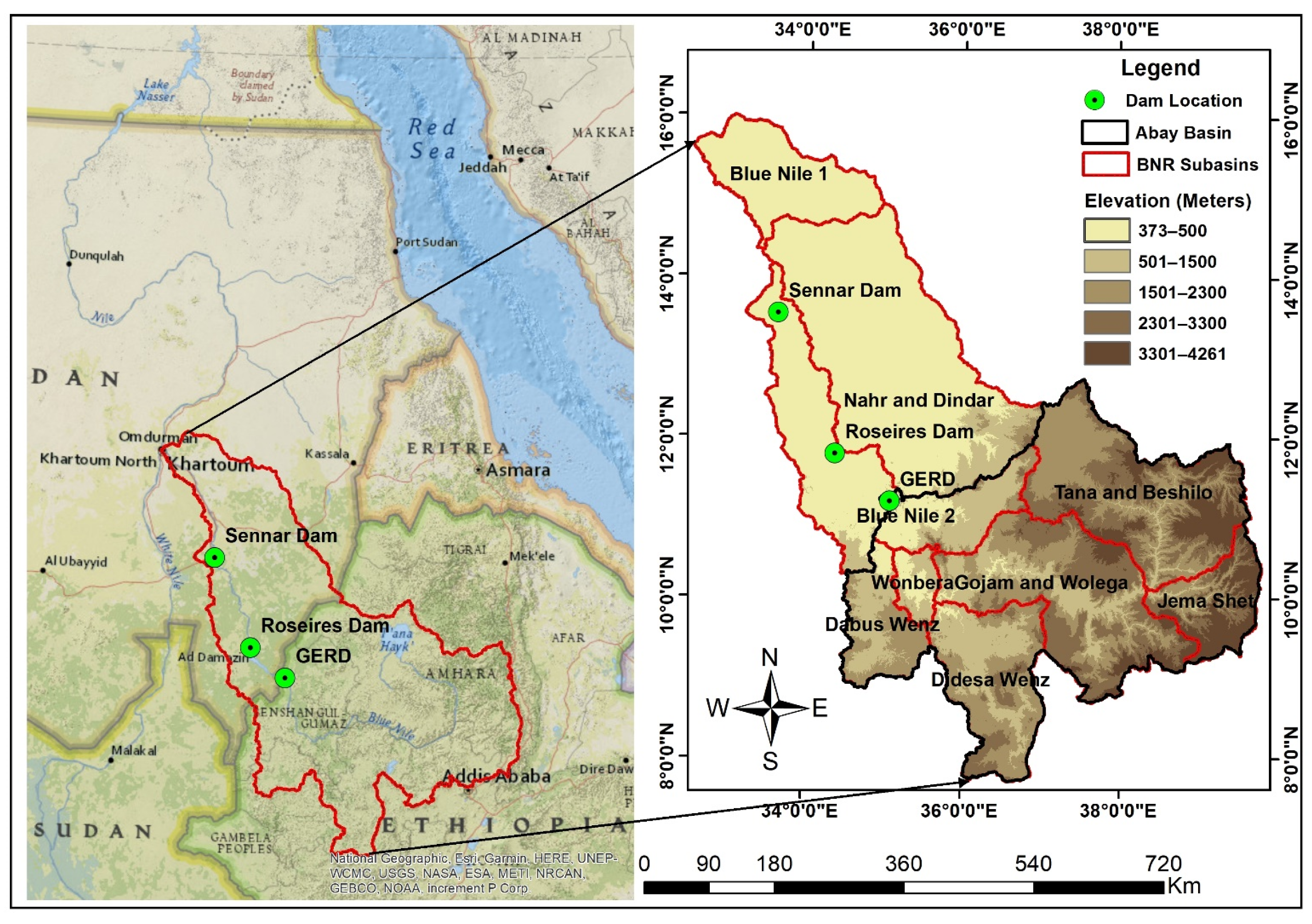
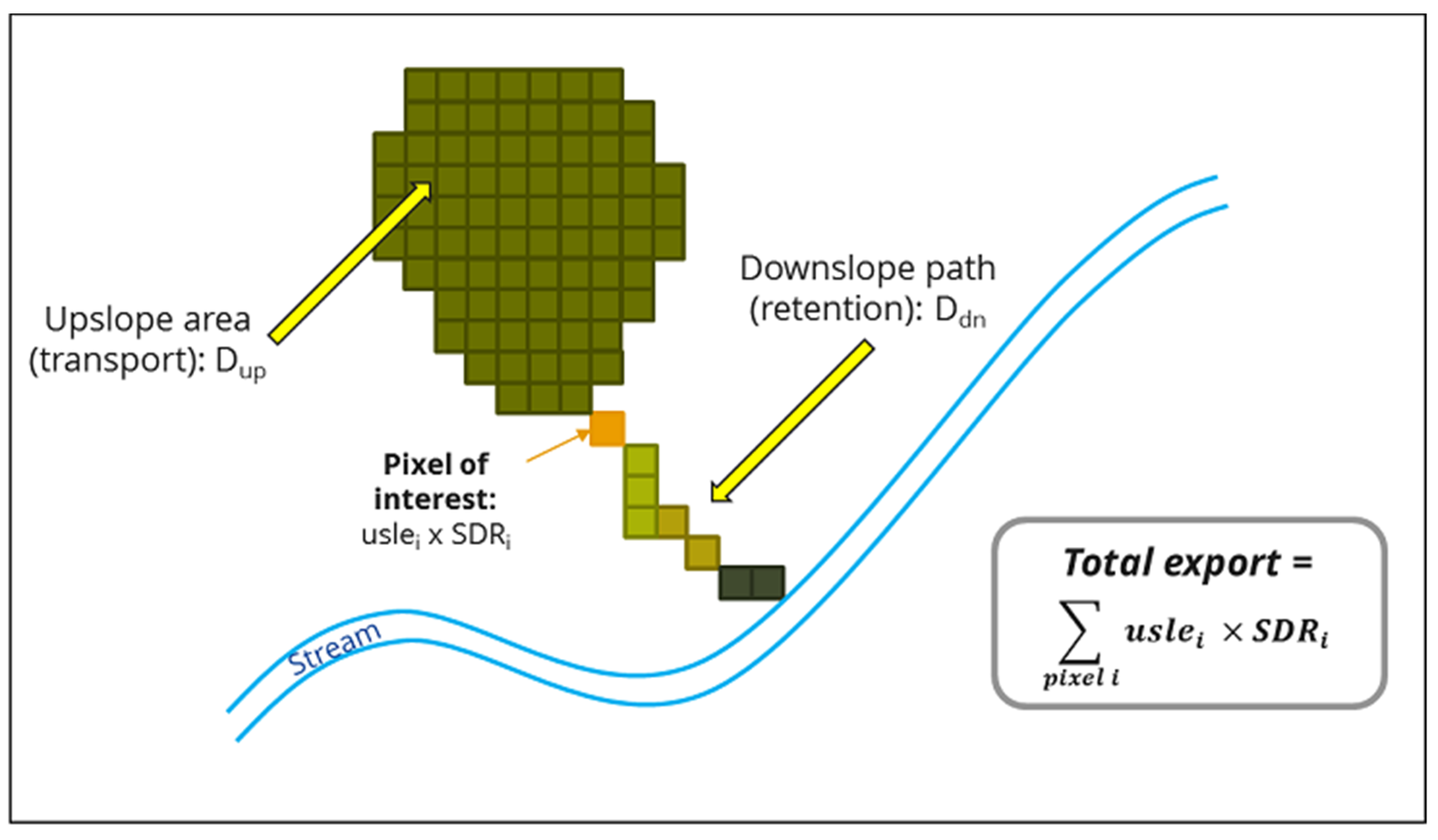
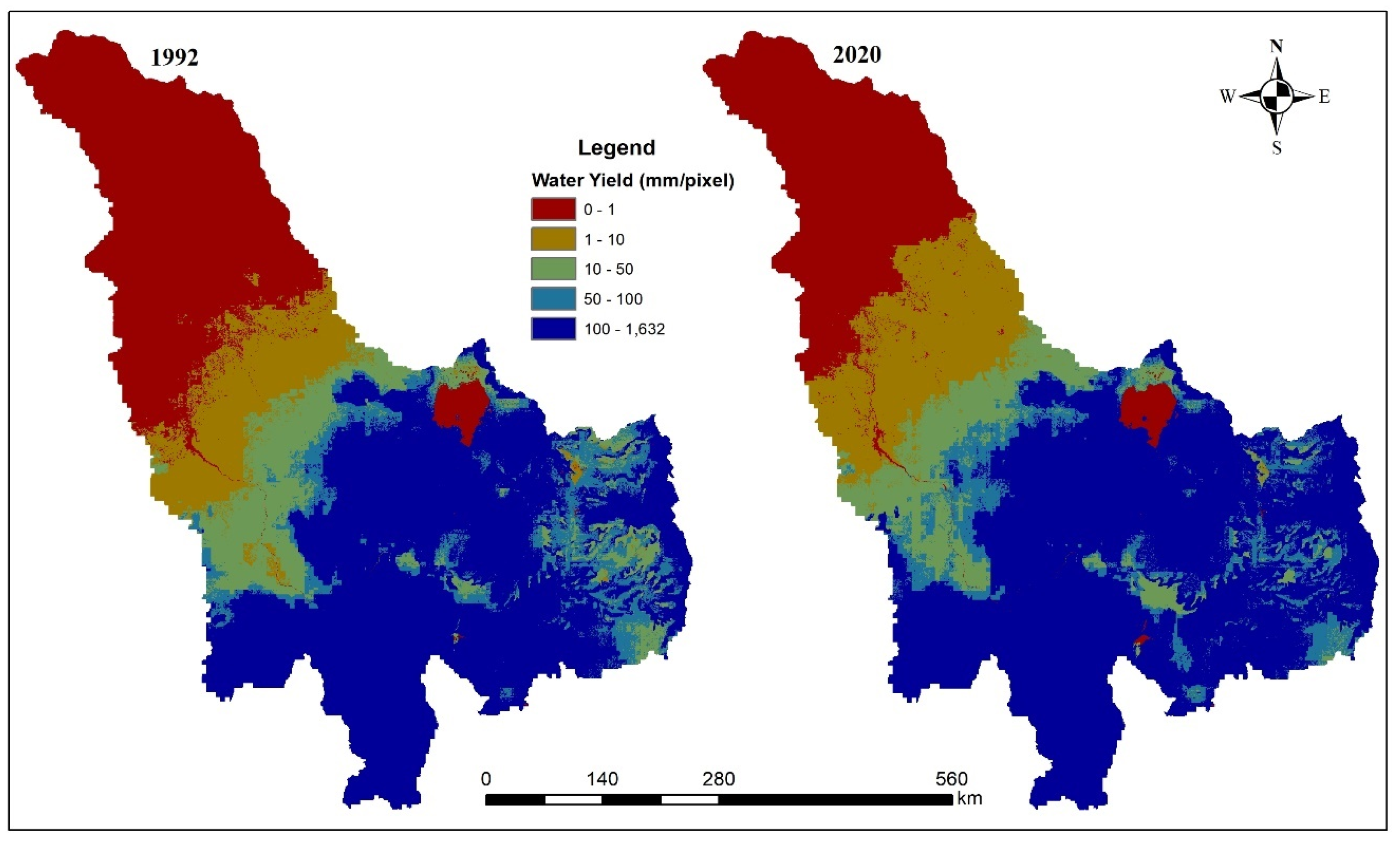
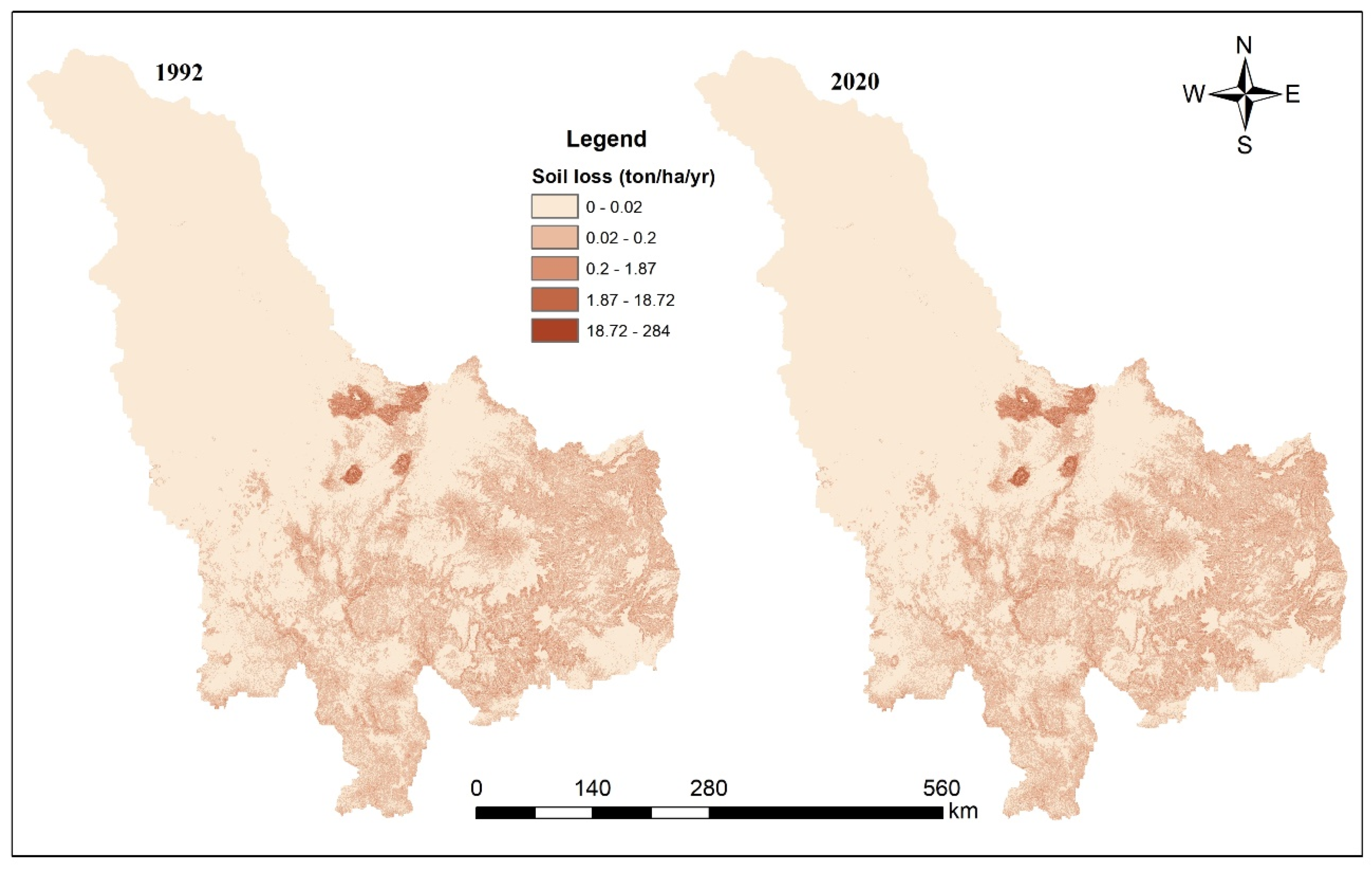
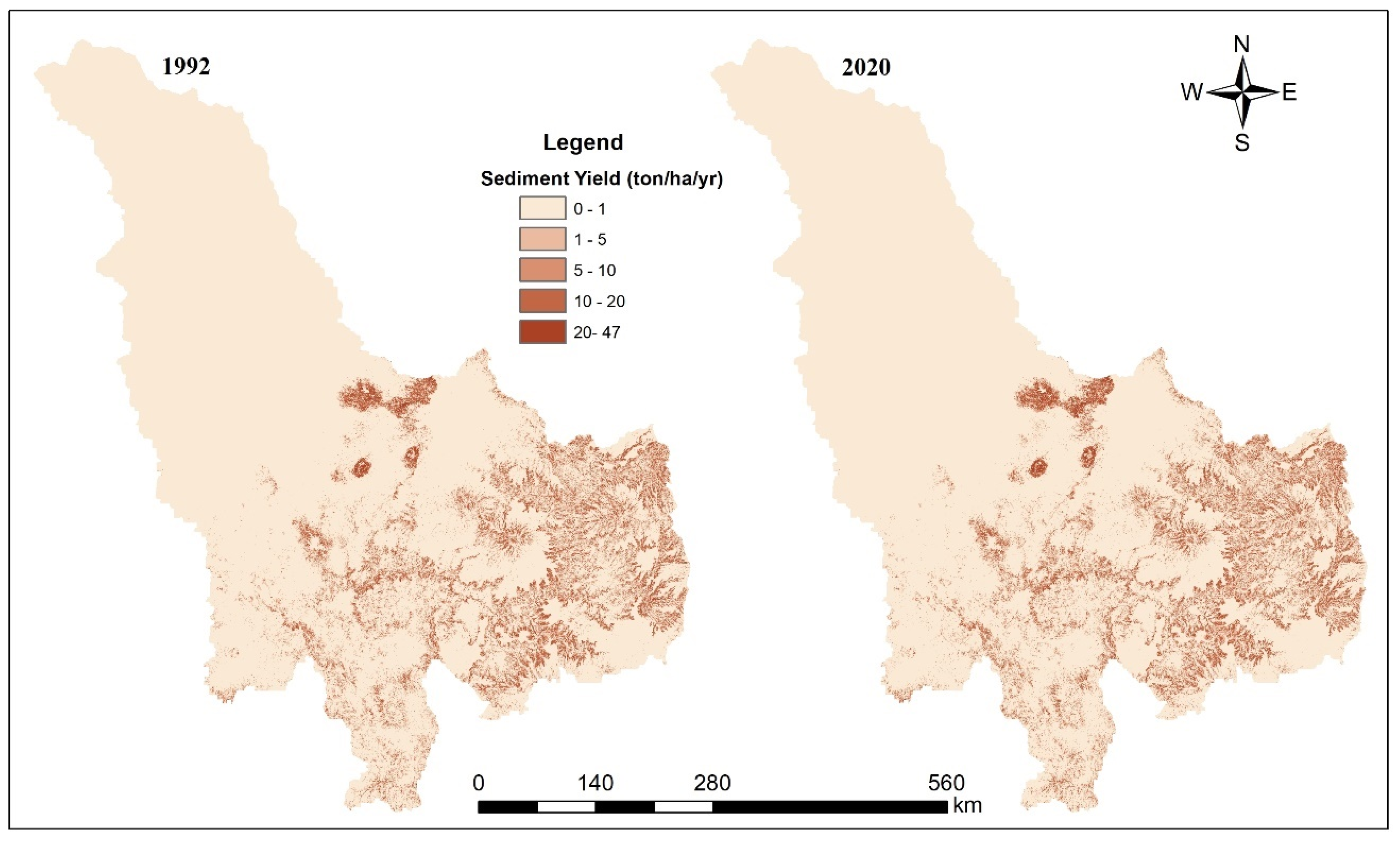
| Year | Precipitation (mm) | PET (mm) | AET (mm) | Water Yield (mm) | Water Yield Volume (m3) |
|---|---|---|---|---|---|
| 1992 | 974 | 1800 | 823 | 151 | 48,264,761,929 |
| 2000 | 1038 | 1819 | 874 | 164 | 52,531,853,703 |
| 2010 | 1024 | 1809 | 862 | 162 | 51,885,682,435 |
| 2020 | 1062 | 1810 | 882 | 180 | 57,833,607,276 |
| Year | Cropland | Mosaic Cropland | Mosaic Natural Vegetation | Woodland (Pastoral) | Forest | Shrubland | Grassland | Wetland | Urban Area | Bare Area | Water Bodies | Mean/ Total | |
|---|---|---|---|---|---|---|---|---|---|---|---|---|---|
| 1992 | MWY | 132.31 | 261.81 | 167.77 | 234.25 | 31.64 | 97.97 | 3.74 | 115.30 | 156.41 | 6.60 | 6.20 | 150.81 |
| MSY | 3.72 | 6.57 | 6.80 | 4.87 | 0.34 | 1.31 | 0.08 | 0.55 | 0.04 | 0.01 | 0.00 | 3.71 | |
| Area (km2) | 88,330 | 21,408 | 36,767 | 78,542 | 6818 | 60,243 | 18,030 | 440 | 210 | 4174 | 4468 | 319,434 | |
| 2000 | MWY | 163.78 | 261.50 | 143.96 | 241.65 | 41.17 | 122.62 | 4.05 | 147.57 | 175.94 | 13.97 | 2.21 | 164.25 |
| MSY | 4.35 | 6.52 | 5.35 | 5.22 | 0.39 | 1.51 | 0.08 | 0.54 | 0.04 | 0.02 | 0.00 | 3.95 | |
| Area (km2) | 78,461 | 22,455 | 50,716 | 80,018 | 6878 | 53,599 | 18,257 | 465 | 250 | 3914 | 4416 | 319,434 | |
| 2010 | MWY | 137.75 | 259.94 | 165.09 | 255.75 | 37.45 | 106.26 | 4.18 | 125.36 | 142.29 | 10.83 | 0.82 | 162.18 |
| MSY | 3.65 | 6.31 | 6.66 | 5.27 | 0.39 | 1.45 | 0.09 | 0.46 | 0.03 | 0.02 | 0.00 | 3.90 | |
| Area (km2) | 93,575 | 23158 | 37,425 | 81,983 | 6789 | 49,484 | 18,825 | 504 | 412 | 2931 | 4342 | 319,434 | |
| 2020 | MWY | 151.44 | 278.38 | 192.60 | 280.73 | 51.13 | 124.15 | 3.81 | 136.61 | 168.62 | 19.17 | 0.66 | 180.89 |
| MSY | 3.67 | 6.35 | 6.94 | 5.46 | 0.47 | 1.49 | 0.09 | 0.52 | 0.02 | 0.03 | 0.00 | 4.00 | |
| Area (km2) | 93,337 | 22,747 | 36,461 | 83,968 | 7269 | 48,537 | 19,000 | 567 | 733 | 2453 | 4357 | 319,434 |
Publisher’s Note: MDPI stays neutral with regard to jurisdictional claims in published maps and institutional affiliations. |
© 2022 by the authors. Licensee MDPI, Basel, Switzerland. This article is an open access article distributed under the terms and conditions of the Creative Commons Attribution (CC BY) license (https://creativecommons.org/licenses/by/4.0/).
Share and Cite
Li, P.; He, Z.; Cai, J.; Zhang, J.; Belete, M.; Deng, J.; Wang, S. Identify the Impacts of the Grand Ethiopian Renaissance Dam on Watershed Sediment and Water Yields Dynamics. Sustainability 2022, 14, 7590. https://doi.org/10.3390/su14137590
Li P, He Z, Cai J, Zhang J, Belete M, Deng J, Wang S. Identify the Impacts of the Grand Ethiopian Renaissance Dam on Watershed Sediment and Water Yields Dynamics. Sustainability. 2022; 14(13):7590. https://doi.org/10.3390/su14137590
Chicago/Turabian StyleLi, Peng, Zhen He, Jianwu Cai, Jing Zhang, Marye Belete, Jinsong Deng, and Shizong Wang. 2022. "Identify the Impacts of the Grand Ethiopian Renaissance Dam on Watershed Sediment and Water Yields Dynamics" Sustainability 14, no. 13: 7590. https://doi.org/10.3390/su14137590
APA StyleLi, P., He, Z., Cai, J., Zhang, J., Belete, M., Deng, J., & Wang, S. (2022). Identify the Impacts of the Grand Ethiopian Renaissance Dam on Watershed Sediment and Water Yields Dynamics. Sustainability, 14(13), 7590. https://doi.org/10.3390/su14137590







